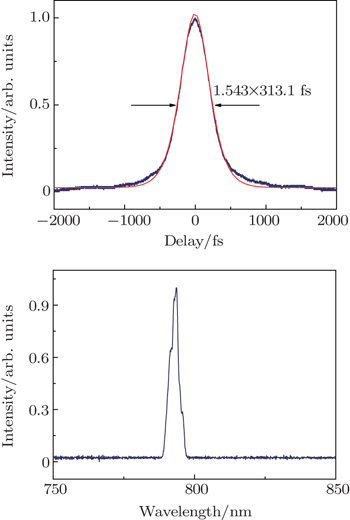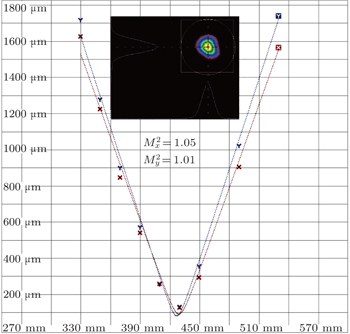† Corresponding author. E-mail:
‡ Corresponding author. E-mail:
Project supported by the National Key Basic Research Program of China (Grant No. 2013CB922402), the National Key Scientific Instruments Development Program of China (Grant No. 2012YQ120047), the National Natural Science Foundation of China (Grant Nos. 61205130 and 11174361), and the Key Deployment Project of Chinese Academy of Sciences (Grant No. KJZD-EW-L11-03).
We demonstrate a widely tunable near-infrared source from 767 nm to 874 nm generated by the intracavity second harmonic generation (SHG) in an optical parametric oscillator pumped by a Yb:LYSO solid-state laser. The home-made Yb:LYSO oscillator centered at 1035 nm delivers an average power of 2 W and a pulse duration as short as 351 fs. Two MgO doped periodically poled lithium niobates (MgO:PPLN) with grating periods of 28.5–31.5 μm in steps of 0.5 μm and 19.5–21.3 μm in steps of 0.2 μm are used for the OPO and intracavity SHG, respectively. The maximum average output power of 180 mW at 798 nm was obtained and the output pulses have pulse duration of 313 fs at 792 nm if a sech 2 -pulse shape was assumed. In addition, tunable signal femtosecond pulses from 1428 nm to 1763 nm are also realized with the maximum average power of 355 mW at 1628 nm.
Ultrafast laser sources in the near-infrared (NIR) wavelengths around 700–1000 nm region have attracted increasing interest as efficient tools for various applications including biophotonics, optical microscopy, CARS spectroscopy, and pumping OPO. [ 1 – 4 ] Kerr-lens mode-locked Ti:sapphire lasers as the mainstay in this aspect have been well-established and widely utlized for the majority of applications for so long. [ 5 – 7 ] However, the high cost, large size, relatively high complexity as well as the need for water-cooling remain along with the Ti:sapphire lasers. Another attractive alternative approach to the femtosecond pulses in this spectra range is the synchronously pumped optical parametric oscillators (SPOPOs) of two types. One kind is the femtosecond green sources pumped SPOPOs, and another is the intracavity second harmonic generation (SHG) of the signal resonant SPOPOs pumped by high-power femtosecond laser near 1 μm. For the green sources which are generally generated by frequency-doubled femtosecond laser emitting at 1 μ m pumping the SPOPOs that produce NIR wavelengths, common quasi-phase-matched (QPM) materials such as MgO-doped periodically poled lithium niobate (MgO:PPLN) are incompetent due to the effects of photo-refraction, green-induced infrared absorption, nonlinear absorption, gray tracking, and the large group velocity mismatch (GVM) between the pump (green) and signal (near-infrared) which results in very short parametric crystal. Instead, lithium triborate (LBO) has long been used for femtosecond green sources pumped SPOPOs, due to the high damage threshold and the possibility of noncritical phase matching (NCPM). Recently, Cleff et al. reported a femtosecond OPO based on LiB 3 O 5 pumped by a frequency-doubled Yb-fiber amplifier at 525 nm provided signal tuning over 780–940 nm with more than 250 mW. [ 8 ] A dual-wavelength femtosecond LiB 3 O 5 OPO pumped by frequency-doubled Yb-fiber laser covered the visible and NIR wavelengths over 555–623 nm and 658–846 nm. [ 9 ] Lang et al. reported ultra-widely tunable femtosecond pulses covering 600–1200 nm with more than 3 W average power from a non-collinear OPO based on BBO pumped by the SHG of a femtosecond Yb:KLu(WO 4 ) 2 thin-disk laser oscillator. [ 10 ] Most recently, both LBO and BBO SPOPOs pumped by the SHG of a femtosecond Yb:KGW laser were also realized. [ 11 ] On the other hand, that generating NIR femtosecond pulses from the intracavity SHG or sum-frequency-generation (SFG) between the pump and signal in high-power SPOPOs pumped by femtosecond laser at 1 μm seem to be a feasible and interesting topic, due to the rapid development of the femtosecond laser at 1 μm as well as the QPM technology. Up to now, only Gu et al. has reported on the intracavity SHG and SFG in an Yb-fiber laser pumped optical parametric oscillator, generating femtosecond pulses over 610–668 nm for SFG and 716–970 nm for SHG with high efficiency. [ 12 ]
In this paper, we demonstrate a widely tunable near-infrared source from 767 nm to 874 nm based on the intracavity SHG in an SPOPO pumped by a home-made Yb:LYSO solid-state laser which delivers femtosecond pulses centered at 1035 nm with an average power of 2 W and a pulse duration as short as 351 fs. Two MgO:PPLNs with grating periods of 28.5–31.5 μm in steps of 0.5 μm and 19.5–21.3 μm in steps of 0.2 μm are used for the OPO and intracavity SHG, respectively. The maximum average output power is 180 mW at 798 nm and has good power stability with root-mean-square (RMS) < 2.3% in 2 hours. The output pulses have the duration of 313 fs at 792 nm if a sech 2 -pulse shape was assumed. In addition, tunable signal femtosecond pulses from 1428 nm to 1763 nm are also realized with the maximum average power of 355 mW at 1628 nm.
The experimental setup of the intracavity SHG of a SPOPO pumped by a femtosecond Yb:LYSO laser is shown in Fig.
At first, we characterized the performance of OPO without SHG. The second MgO:PPLN was not inserted in the cavity and the HR was replaced by an output coupler (OC) with 3% transmission over 1220–1740 nm. By conveniently adjusting the OPO cavity length and tuning the grating periods of the first MgO:PPLN from 28.5 μm to 31.5 μm, a broad tunable signal between 1427–1763 nm with 336 nm tunable range was obtained, as described in Fig.
Under the maximum pump power after the isolator system and the second HWP, the signal output power can reach 355 mW at 1628 nm. The corresponding idle power should be 203 mW according to the conservation of photon number and is centered at 2841.5 nm. The maximum total extraction efficiency is 31.0%. The output power depending on the tuning signal wavelengths is recorded in Fig.
To realize intracavity SHG, we use the HR to replace the OC, and the second MgO:PPLN was inserted at the center between C3 and C4. The SHG pulses were extracted from C4 with 80% transmittance at 796 nm. At first, we obtained tunable signal pulses along with SHG by adjusting the OPO cavity length and tuning the grating periods of the first MgO:PPLN. The maximum SHG power at every available wavelength was obtained by finely changing the grating periods of the second MgO:PPLN. During the experiment, broad tunable near-IR pulses from 767 nm to 874 nm were realized, and the corresponding signal wavelength was from 1534 nm to 1748 nm. The maximum average power of the SHG pulses was measured to be 180mW at 798 nm, corresponding to 10% conversion efficiency.
The power scale of the SHG pulses at 798 nm was also recorded as shown in Fig.
The temporal character of the SHG signal of the femtosecond OPO was measured with a commercial intensity autocorrelator (FR-103MN, Femtochrome Research, Inc.). Representative result with the SHG operating at 792 nm was shown in Fig.
The beam quality of the SHG pulses was also measured with a commercial laser beam propagation analyzer (M2-200s-FW, Ophir-Spiricon, Inc.) as shown in Fig.
To conclude, we demonstrated an Yb:LYSO laser pumped femtosecond OPO. Tunable signal from 1428 nm to 1763 nm as well as idler over 2563–3768 nm were achieved. A maximum average output power of 355 mW at 1628 nm was obtained, corresponding to an idler power of 203 mW at 2841.5 nm as well as 31% total extraction efficiency. By inserting another MgO:PPLN with grating periods 19.5 μm to 21.3 μm in steps of 0.2 μm, efficient SHG pulses from 767 nm to 874 nm with a good beam quality of 1.01 and 1.05 for the tangential direction and sagittal direction, respectively, were realized. The maximum average output power of SHG pulses was 180 mW at 798 nm with a good power stability of RMS< 2.3% in two hours. The temporal character of the SHG signal at 792 nm was measured to be 313 fs, corresponding to a TBP of 0.6. It is believed to generate near-transform limited near-IR pulses if proper dispersion compensation elements were used in the cavity.
| 1 | |
| 2 | |
| 3 | |
| 4 | |
| 5 | |
| 6 | |
| 7 | |
| 8 | |
| 9 | |
| 10 | |
| 11 | |
| 12 |










